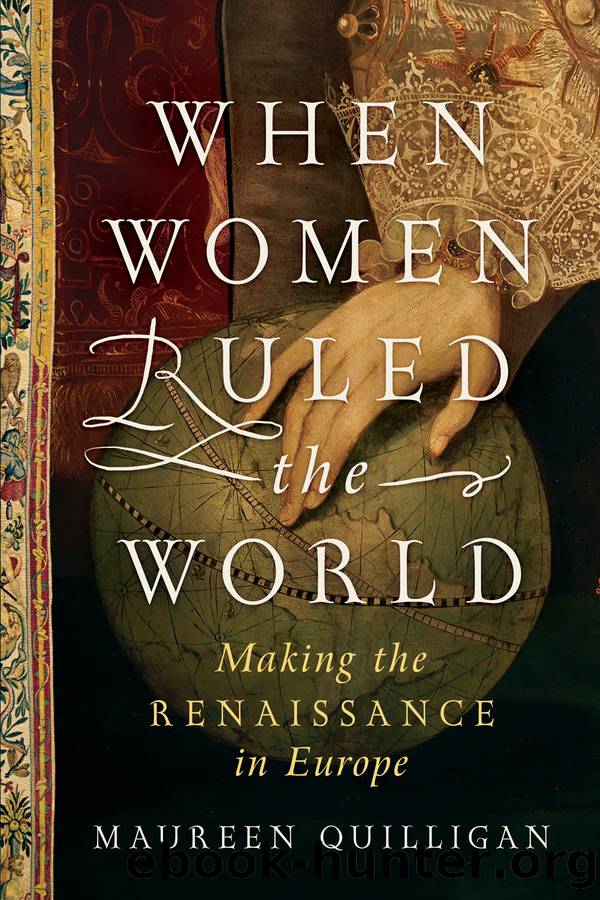When Women Ruled the World by Maureen Quilligan

Author:Maureen Quilligan
Language: eng
Format: epub
Publisher: Liveright
Published: 2021-09-08T00:00:00+00:00
Hardwick Hall, Derbyshire: west front, seen from the gatehouse.
It looks to be a great act of generosity for Bess to allow a portrait of Mary as âChastityâ to be created and to remain at Hardwick. Having become one of Hardwick Hallâs inalienable posessions, it seems to proclaim Bessâs acceptance of the innocence of Mary, Queen of Scots, even after she had been executed for treason and for allegedly consenting to the assassination of Elizabeth. But in a sense, the hanging spoke to details of Maryâs earlier life, specifically her compromised sexual purity. Lucretia had, afer all, been raped by Tarquin, and many of Maryâs supporters understood her true downfall to have been the result of Bothwellâs abduction and probable rape of her. Perhaps Bess of Hardwick was acknowledging that it is possible for a woman to remain pure even after rape, and that she did not need to commit suicide (as Lucretia did) in order to erase the stain of the attack.19
Maryâs supporters repeatedly put out propaganda to counter the stories circulating to smear Maryâs name; one of these documents was a fake âconfessionâ by, supposedly, the Earl of Bothwell himself, although he actually had died in 1578 in prison in Denmarkâaccording to legend, chained to the prison wall and mad. In fact, as a nobleman, he enjoyed relatively elegant surroundings in the prison provided by his jailer. When Darnleyâs mother, the Countess of Lennox, read the forged âconfession,â she decided that Mary had been falsely accused and that she had been innocent of the murder charge all along. The countess sent Mary a letter of reconciliation and a piece of elegant lace embroidery into which she had woven strands of her own silver hair.
Margaret, the dowager countess of Lennox, would have been a family member with whom Bess of Hardwick needed to communicate when arranging the marriage of her daughter Elizabeth Cavendish to the countessâs youngest son. For a mother to forgive someone who she had once supposed to have conspired to murder her oldest son (Darnley) is a strong testament to that personâs innocence, even if the change of heart is based on a forgery. The countessâs turnaround may have had an effect on Bessâs opinion of Mary.
The fact that the most famous picture of Mary is of her in mourning garb is something she shares with her mother-in-law, Catherine deâ Medici, who, as we shall see, also wore mourning throughout her entire life after the death of her husband, Henri II. Mary would have seen her mother-in-lawâs mourning dress daily when she was queen consort of France, married to François II for the months of his short reign; after his death, she left for Scotland. Unlike Catherine, Mary did not continue always to wear mourning, but she must have understood how a portrait in those clothes allowed people to remember her royal virginal widowhood. Mary wore white, while Catherine wore black, but as both of them were dowager queens of France, each was insisting on the privileged position of a kingâs widow through their physical representations in major works of art.
Download
This site does not store any files on its server. We only index and link to content provided by other sites. Please contact the content providers to delete copyright contents if any and email us, we'll remove relevant links or contents immediately.
| Africa | Americas |
| Arctic & Antarctica | Asia |
| Australia & Oceania | Europe |
| Middle East | Russia |
| United States | World |
| Ancient Civilizations | Military |
| Historical Study & Educational Resources |
The Third Pole by Mark Synnott(914)
Money for Nothing by Thomas Levenson(896)
The Economist (20210109) by calibre(894)
Christian Ethics by Wilkens Steve;(824)
Made in China by Anna Qu(809)
The Age of Louis XIV: The Story of Civilization by Will Durant(786)
Reopening Muslim Minds by Mustafa Akyol(767)
Nonstate Warfare by Stephen Biddle(766)
100 Posters That Changed The World by Salter Colin T.;(750)
The Shortest History of China by Linda Jaivin(721)
The Great Pyramid Void Enigma by Scott Creighton(717)
The Irish Buddhist by Alicia Turner(714)
Culture by Terry Eagleton(712)
Ideology by Eagleton Terry;(696)
Routledge Handbook of Contemporary India by Knut A. Jacobsen(693)
Sybille Bedford by Selina Hastings(655)
The Jews of Silence: A Personal Report on Soviet Jewry by Elie Wiesel(649)
Objects of Vision by Saab A. Joan;(637)
Banaras: CITY OF LIGHT by Diana L. Eck(628)
